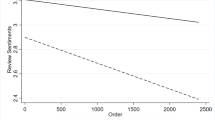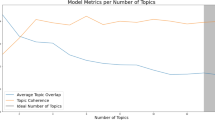Abstract
Several studies have focused on the effects of online negative customer reviews on sales, especially pertaining to Internet shopping and e-retailing. However, there is mixed evidence and the theoretical studies have mainly focused on the volume and valence. To understand the effects of negative customer reviews on sales, the present study uses text data mining techniques to investigate how three factors, namely “content topic, proportion, and consistency,” bout the textual content of negative customer reviews influence online sales. Relevant data were collected from a large-scale online shopping platform. The results of content association and topic extraction reveal four topics—product quality, delivery service, cost performance, and taste. A new econometric model proposed in this study shows that different topics have different effects on sales. Negative customer reviews with a higher percentage or consistency about these four topics significantly jeopardize product sales. Theoretical and managerial implications and future research directions are also presented.










Similar content being viewed by others
Notes
A kind of casual snack that can be eaten after opening the packing.
A stock keeping unit (SKU) is a 6–8 character long alphanumeric code used to identify a product and track its inventory. The SKU for each product and seller is a unique number.
The mode is the value that appears most often in the dataset.
The Jaccard index is a statistic used for comparing the similarity and diversity of sample sets.
A self-organizing map is a type of artificial neural network that uses unsupervised learning to build a two-dimensional map of a problem space.
In order to make the model developed from the training set reasonably applicable to test set, this study assumes that the data are independent identically distributed. What’s more, the present study mainly highlights the sales effects of negative online reviews rather than sales forecast. Therefore, in the present study, the error term is assumed as i.i.d. distributed to simplify the model.
The correlation coefficient between \(x_{2i,t}\) and \(S_{i,t-1}\) is 0.794.
Random effects (RE) model is preferred under the null hypothesis because of higher efficiency, while under the alternative fixed effects (FE) model is at least consistent and thus preferred.
References
Dellarocas, C. (2003). The digitization of word of mouth: Promise and challenges of online feedback mechanisms. Management Science, 49(10), 1407–1424.
Godes, D., & Mayzlin, D. (2004). Using online conversations to study word of mouth communication. Marketing Science, 23(4), 545–560.
Chu, S. C., & Kim, Y. (2011). Determinants of consumer engagement in electronic word-of-mouth (eWOM) in social networking sites. International Journal of Advertising, 30(1), 47–75.
Doh, S. J., & Hwang, J. S. (2009). How consumers evaluate eWOM (electronic word-of-mouth) messages. CyberPsychology & Behavior, 12(2), 193–197.
Hennig-Thurau, T., Walsh, G., & Walsh, G. (2003). Electronic word of mouth: Motives for and consequences of reading customer articulations on the internet. International Journal of Electronic Commerce, 8(2), 51–74.
Duan, W., Gu, B., & Whinston, A. B. (2008). The dynamics of online word-of-mouth and product sales—An empirical investigation of the movie industry. Journal of Retailing, 84(2), 233–242.
Floyd, K., Freling, R., Alhoqail, S., Cho, H. Y., & Freling, T. (2014). How online product reviews affect retail sales: A meta-analysis. Journal of Retailing, 90(2), 217–232.
Gu, B., Park, J., & Konana, P. (2012). The impact of external word-of-mouth sources on retailer sales of high-involvement products. Information Systems Research, 23(1), 182–196.
Chevalier, J. A., & Mayzlin, D. (2006). The effect of word of mouth on sales: Online book reviews. Journal of Marketing Research, 43(3), 345–354.
Dellarocas, C. (2006). Strategic manipulation of internet opinion forums: Implications for consumers and firms. Management Science, 52(10), 1577–1593.
Chiou, J. S., & Cheng, C. (2003). Should a company have message boards on its web sites? Journal of Interactive Marketing, 17(3), 50–61.
Fowler, G. A., & Avila, J. D. (2009). On the internet, everyone’s a critic but they’re not very critical. The Wall Street Journal.
Chatterjee, P. (2001). Online reviews: Do consumers use them? Advances in Consumer Research, 28, 129–133.
Kusumasondjaja, S., Shanka, T., & Marchegiani, C. (2012). Credibility of online reviews and initial trust: The roles of reviewer’s identity and review valence. Journal of Vacation Marketing, 18(3), 185–195.
Papathanassis, A., & Knolle, F. (2011). Exploring the adoption and processing of online holiday reviews: A grounded theory approach. Tourism Management, 32(2), 215–224.
Zhang, J. Q., Craciun, G., & Shin, D. (2010). When does electronic word-of-mouth matter? A study of consumer product reviews. Journal of Business Research, 63(12), 1336–1341.
Basuroy, S., Chatterjee, S., & Ravid, S. A. (2003). How critical are critical reviews? The box office effects of film critics, star power, and budgets. Journal of Marketing, 67(4), 103–117.
Chen, Y., Wang, Q., & Xie, J. (2011). Online social interactions: A natural experiment on word of mouth versus observational learning. Journal of Marketing Research, 48(2), 238–254.
Ho-Dac, N. N., Carson, S. J., & Moore, W. L. (2013). The effects of positive and negative online customer reviews: Do brand strength and category maturity matter? Journal of Marketing, 77(6), 37–53.
Rosario, A Babić, Sotgiu, F., De Valck, K., & Bijmolt, T. H. (2016). The effect of electronic word of mouth on sales: A meta-analytic review of platform, product, and metric factors. Journal of Marketing Research, 53(3), 297–318.
Liu, Y. (2006). Word of mouth for movies: Its dynamics and impact on box office revenue. Journal of Marketing, 70(3), 74–89.
Tirunillai, S., & Tellis, G. J. (2012). Does chatter really matter? Dynamics of user-generated content and stock performance. Marketing Science, 31(2), 198–215.
Li, X., & Hitt, L. M. (2008). Self-selection and information role of online product reviews. Information Systems Research, 19(4), 456–474.
Ogut, H., & Tas, B. K. Onur. (2012). The influence of internet customer reviews on the online sales and prices in hotel industry. The Service Industries Journal, 32(2), 197–214.
Ye, Q., Law, R., Gu, B., & Chen, W. (2011). The influence of user-generated content on traveler behavior: An empirical investigation on the effects of e-word-of-mouth to hotel online bookings. Computers in Human Behavior, 27(2), 634–639.
Cui, G., Lui, H. K., & Guo, X. (2012). The effect of online consumer reviews on new product sales. International Journal of Electronic Commerce, 17(1), 39–58.
Li, Z., & Shimizu, A. (2018). Impact of online customer reviews on sales outcomes: An empirical study based on prospect theory. The Review of Socionetwork Strategies, 12(2), 135–151.
Yang, J., Kim, W., Amblee, N., & Jeong, J. (2012). The heterogeneous effect of WOM on product sales: Why the effect of WOM valence is mixed? European Journal of Marketing, 46(11/12), 1523–1538.
Zhang, Z., Li, X., & Chen, Y. (2012). Deciphering word-of-mouth in social media: Text-based metrics of consumer reviews. ACM Transactions on Management Information Systems, 3(1), 1–23.
Sonnier, G. P., McAlister, L., & Rutz, O. J. (2011). A dynamic model of the effect of online communications on firm sales. Marketing Science, 30(4), 702–716.
Cho, V., & Chan, A. (2017). A study on the influence of eWOM using content analysis: How do comments on value for money, product sophistication and experiential feeling affect our choices? Enterprise Information Systems, 11(6), 927–948.
Tirunillai, S., & Tellis, G. J. (2014). Mining marketing meaning from online chatter: Strategic brand analysis of big data using Latent Dirichlet allocation. Journal of Marketing Research, 51(4), 463–479.
Baumeister, R. F., Bratslavsky, E., Finkenauer, C., & Vohs, K. D. (2001). Bad is stronger than good. Review of General Psychology, 5(4), 323–370.
Chen, P.Y., Dhanasobhon, S., & Smith, M. D. (2008). All reviews are not created equal: The disaggregate impact of reviews and reviewers at amazon. com. Working Paper. https://doi.org/10.2139/ssrn.918083.
Gruen, T. W., Osmonbekov, T., & Czaplewski, A. J. (2006). eWOM: The impact of customer-to-customer online know-how exchange on customer value and loyalty. Journal of Business Research, 59(4), 449–456.
King, R. A., Racherla, P., & Bush, V. D. (2014). What we know and don’t know about online word-of-mouth: A review and synthesis of the literature. Journal of Interactive Marketing, 28(3), 167–183.
Forman, C., Ghose, A., & Wiesenfeld, B. (2008). Examining the relationship between reviews and sales: The role of reviewer identity disclosure in electronic markets. Information Systems Research, 19(3), 291–313.
Dowling, G. R., & Staelin, R. (1994). A model of perceived risk and intended risk-handling activity. Journal of Consumer Research, 21(1), 119–134.
Taylor, J. W. (1974). The role of risk in consumer behavior. The Journal of Marketing, 38(2), 54–60.
Stewart, K. J. (2003). Trust transfer on the world wide web. Organization Science, 14(1), 5–17.
Girard, T., & Dion, P. (2010). Validating the search, experience, and credence product classification framework. Journal of Business Research, 63(9), 1079–1087.
Ye, Q., Xu, M., Kiang, M., Wu, W., & Sun, F. (2013). In-depth analysis of the seller reputation and price premium relationship: A comparison between eBay US and TaoBao China. Journal of Electronic Commerce Research, 14(1), 1–10.
Liao, T. H., & Keng, C. J. (2013). Online shopping delivery delay: Finding a psychological recovery strategy by online consumer experiences. Computers in Human Behavior, 29(4), 1849–1861.
Forsythe, S. M., & Shi, B. (2003). Consumer patronage and risk perceptions in internet shopping. Journal of Business Research, 56(11), 867–875.
Wood, W., Lundgren, S., Ouellette, J. A., Busceme, S., & Blackstone, T. (1994). Minority influence: A meta-analytic review of social influence processes. Psychological Bulletin, 115(3), 323–345.
Latané, B., & Wolf, S. (1981). The social impact of majorities and minorities. Psychological Review, 88(5), 438–453.
Tanford, S., & Penrod, S. (1984). Social influence model: A formal integration of research on majority and minority influence processes. Psychological Bulletin, 95(2), 189–225.
Moscovici, S., & Personnaz, B. (1980). Studies in social influence: V. Minority influence and conversion behavior in a perceptual task. Journal of Experimental Social Psychology, 16(3), 270–282.
Moscovici, S. (1985). Social Influence and Conformity. Handbook of Social Psychology.
Turner, J. C. (1991). Social Influence. Pacific Grove: Thomson Brooks/Cole Publishing Co.
Nemeth, M. C., Swedlund, M., & Kanki, B. (1974). Patterning of the minority’s response and their influence on the majority. European Journal of Social Psychology, 4(1), 53–64.
He, S. X., & Bond, S. D. (2015). Why is the crowd divided? Attribution for dispersion in online word of mouth. Journal of Consumer Research, 41(6), 1509–1527.
Lee, C. H., & Cranage, D. A. (2014). Toward understanding consumer processing of negative online word-of-mouth communication: The roles of opinion consensus and organizational response strategies. Journal of Hospitality & Tourism Research, 38(3), 330–360.
Chang, H. H., & Wu, L. H. (2014). An examination of negative e-WOM adoption: Brand commitment as a moderator. Decision Support Systems, 59, 206–218.
Zhu, M., & Lai, S. (2009). A study about the WOM influence on tourism destination choice. In 2009 International conference on electronic commerce and business intelligence, pp. 120–124.
Blei, D. M., Ng, A. Y., & Jordan, M. I. (2003). Latent Dirichlet allocation. Journal of Machine Learning Research, 3, 993–1022.
Chuang, J., Manning, C. D., & Heer, J. (2012). Termite: Visualization techniques for assessing textual topic models. In Proceedings of the international working conference on advanced visual interfaces (pp. 74–77). ACM.
Sievert, C., & Shirley, K. (2014). LDAvis: A method for visualizing and interpreting topics. In Proceedings of the workshop on interactive language learning, visualization, and interfaces, pp. 63–70.
Zhang, J., Wedel, M., & Pieters, R. (2009). Sales effects of attention to feature advertisements: A Bayesian mediation analysis. Journal of Marketing Research, 46(5), 669–681.
Acknowledgements
We thank the editor and the anonymous reviewers for their thoughtful reviews and constructive suggestions during the review process. This work was supported by JSPS KAKENHI Grant numbers JP15H06747, JP17K18152, and the National Natural Science Foundation of China NSFC71572065.
Author information
Authors and Affiliations
Corresponding author
Additional information
Publisher's Note
Springer Nature remains neutral with regard to jurisdictional claims in published maps and institutional affiliations.
Rights and permissions
About this article
Cite this article
Li, Z., Li, F., Xiao, J. et al. Topic Features in Negative Customer Reviews: Evidence Based on Text Data Mining. Rev Socionetwork Strat 14, 19–40 (2020). https://doi.org/10.1007/s12626-019-00041-5
Received:
Accepted:
Published:
Issue Date:
DOI: https://doi.org/10.1007/s12626-019-00041-5




